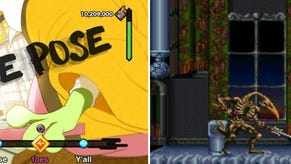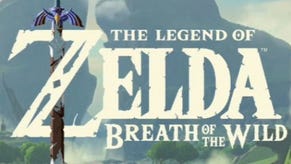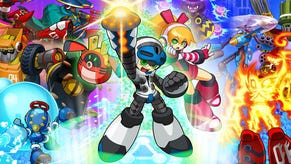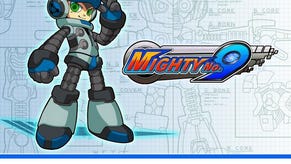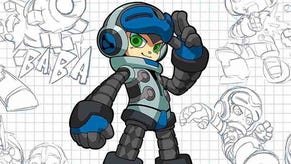The Failure and Fortunes of Red Ash
In part two of our interview, Keiji Inafune speaks about the Mega Man Legends successor's Kickstarter failure and its second lease on life.
This article first appeared on USgamer, a partner publication of VG247. Some content, such as this article, has been migrated to VG247 for posterity after USgamer's closure - but it has not been edited or further vetted by the VG247 team.
I recently spoke to Comcept president Keiji Inafune at the company's Tokyo office. We spoke at length about Mighty No. 9's delay and future prospects, but for me the real meat of the discussion had to do with that game's would-be successor, Red Ash: The Indelible Legend.
Being a long-time fan of the Mega Man Legends series, Red Ash's strong conceptual ties to that charming but decidedly niche corner of the Mega Man franchise won me over immediately. It wasn't the abortive Mega Man Legends 3, precisely, but the concept art and brief tech demo made clear the fact that it would be cut very much from the same cloth. Red Ash's Kickstarter campaign didn't fare nearly as well as Mighty No. 9's, however, and the project seemingly only survived before an obscure publisher called Fuse stepped in at the last minute. In light of all this drama, I was curious to hear more about Comcept's next big project. (Note: This interview picks up exactly where part one left off, so be sure to give that article a read first!)
USGamer: Is that the idea behind Red Ash? To sort of provide that outlet for the Mighty No. 9 universe?
Inafune: In the case of Red Ash... it doesn't really fit into the formula to what I just said about Mega Man series. Red Ash is something that I've always wanted to make, a third-person shooter/action/adventure kind of game, and that's the same thing that our team members wanted. We'd like to think Comcept as a company that does creative first, so we want our team members to make something they want to make.
After Mighty No. 9's successful Kickstarter, we started thinking about creating that game. We already had some ideas within the team, so we thought, "Mighty No. 9's almost there, why don't we start on the next one and kinda keep the momentum of the creative team going and keep motivating them to thinking of something new, keep them working on new ideas?" Almost like keeping their brains in practice. Red Ash is a result of that.
USG: I think the first time I interviewed you, seven or eight years ago, I asked if we'd ever see a Mega Man Legends 3. Of course that never happened, but the concept art for Red Ash and even the title makes its lineage clear. It seems to me that this concept has always been kind of like a special passion project for you.
Inafune: Well, when I think of Red Ash or Mega Man Legends 3, they're totally different things, even though the core idea of what I wanted to do was to have the players, have myself, explore the world in an anime-like style within the game. So that's the core idea behind the game, and that's exactly what we're trying to do with Red Ash—to make that kind of world for the players to explore. I think we're very, very fortunate that we actually have someone who played a huge part in creating the world setting for Mega Man Legends 3 in our team right now, as an art director. So when he makes this world, it's going to be... I'm not going to say "genuine," but it's definitely something that feels right and looks good. So we're very fortunate to have him in the team, and the team is really having fun making this game right now.
And another thing is, an important thing about Red Ash is, even though we have the company Fuse backing us up with funding the game, but they have already said—let me make this clear—that they're not going to interfere with any kind of creative decisions. All the creative decisions are coming from our side, and we can make this game however the way we want to. There's definitely that creative freedom that a developer wouldn't normally have when a publisher is funding the project. But in this case, we're fortunate to have that freedom. So the entire team's just exploring ideas, brainstorming all the time, and thinking about what will make this world fun for players to explore.
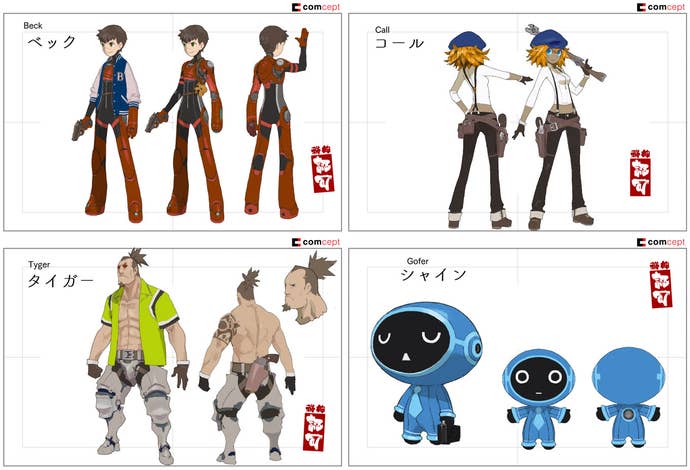
USG: Yeah, I realize this is not a continuation of Mega Man Legends, but it definitely has the same spirit, the same… I don't know, there was something very unique about Legends that what I've seen of this seems to capture. Even the demo, I thought, even though that was just a very simple tech demo, it was like, "I get it." It felt very familiar.
Inafune: Like you said, it's a feeling that you feel when you play the game, or when you see the game—you know, when you play the demo. There's no a written formula for this. I think we can only achieve that kind of feeling by having those exact same people, the people who made Legends 3, having them coming together, thinking about ideas, coming up with a new way to make the game. I think this is a very important part of why this game feels so familiar: The team members are really proud of what they had made before.
So based on that… maybe "pride" is not the best word, but based on that, what they're doing right now is... they're not trying to make exactly the same thing of what they did before, they're trying to regain their glory. What they're making is they're definitely proud of, and when you have that kind of feeling behind your creative process, that's when something good will happen. And like you said, if players like you don't have that feeling, I won't give the OK to the game, to the team, so we'll keep trying and keep making Red Ash until it feels right.
USG: You make it sound like there is a lot of passion and enthusiasm for this project, not just on your part, but within the whole team. With that in mind, I assume that the failure of the Kickstarter was frustrating, disappointing. Can you share some insights into why you think that didn't work out?
Inafune: Yeah, the team was definitely frustrated and disappointed when they see that the campaign was not going to work out. But one thing I noticed about the Red Ash campaign, or rather about the team, is that up until the Kickstarter campaign started, the team really wanted to make the game—it was all about making Red Ash happen. But once the Kickstarter began, the goal became to make the Kickstarter a success. The goal sort of shifted toward that side. All the decisions then were based on the Kickstarter, not based on Red Ash. I think that's one of the big things—bad things—that happened to the team.
So I gathered the team members together, and I told them, "Doing a successful Kickstarter is important, but that's not our final goal. Our final goal is to make Red Ash happen, to make this game. So even if we fail at Kickstarter, that's totally fine; that's one option we'll explore. It if doesn't work, we'll go to the next option. We'll find something else."
This was still during the Kickstarter campaign—we started talking to publishers and we received several offers from outside once the Kickstarter started. That's when the conversation with Fuse started... it was about one week into the Kickstarter campaign. So we explored that side of it, and we were successfully able to get the deal made within that short time period. At that point, the team definitely gained its motivation back, and from there, their minds were set on making this game happen, not Kickstarter. Even though we did try to make the Kickstarter happen, but the main goal, the bigger goal behind the campaign, is to make Red Ash happen.
USG: How does the involvement of Fuse change the nature of the project that you're working on? I mean, the Kickstarter presented the base game as actually a pretty compact story, with stretch goals to expand the volume of the game. Is that still the structure that you're looking at, or does having Fuse involved mean you can just create the full scope of the game that you wanted to begin with?
Inafune: With the Fuse funding, the structure is not exactly different, but we actually have to think differently when we make this game, scheduling and planning, because like you said, when this was a Kickstarter campaign, there is – we always have to leave room open for additional content and all of that stuff, but now with Fuse funding, there's that cap happened with the funding, with the budget. So within the budget, we have to make this game a whole game, to make a finished product.
If there were more funding coming in, then we would add the content inside the existing world. So maybe the world will turn smaller than we originally intended, but still, the story within this world will be a full story, and there's a beginning and also there's an end. So in a way, it's kind of traditional way to make the game, but like I said previously, there's no restriction in the creative side, so we can think freely about the game.

USG: A more finite game world, but lots of things to do, lots of content inside of that world? So I guess if you wanted to draw a comparison to similar games in the past, it would be maybe more like Mega Man Legends, which was on one island, as opposed to Mega Man Legends 2, which was spread across the world?
Inafune: So yes, technically that should be pretty accurate. In this case, we have this moving city called KalKanon, which the entire story that we have right now is going to be based on. Of course, like I said before, there's a beginning and there's definitely an end to that part of the story happening within this city, so even though it's a small area, there's definitely more things to explore, things to look, and things to find. So people shouldn't get bored just because it's a small area. And when we get more funding, we'll definitely expand the area of exploration and the playtime and that stuff.
USG: Yeah, I always thought that was one of the first Legends' real strengths was that it takes place in this sort of contained space, and over the course of the game, you get to know people and the small stories within that space, and it always feels like there's something fresh happening.
Inafune: The team and I have always been thinking about new ideas to put into the game, about expanding this genre of game. But even if a new idea comes up, with a limited budget, we might not be able to make that idea happen. So at the same time we are coming up with ideas, we are looking for a newer funding and outside resources to make this whole thing happen. The best way, of course, is to have the full budget from the start, and they can freely think of ideas to put into the game, but that's not the case here. And just to make one thing clear, even though we don't have the full budget right now and we failed at the Kickstarter campaign, we haven't given up on Kickstarter yet. So right now, the backers' verdict was "no" to Red Ash, but once we have something more to show, something we're proud to show, we might come back to Kickstarter to see what people think at that time.
USG: One last question on Red Ash: You mentioned that you talked to several different publishers; what was it about Fuse that made you decide, "These are the partners for us"?
Inafune: So the biggest reason we chose to team up with Fuse was that they understood the project better than anybody else. This being a Kickstarter project back then, there was a lot of risk-versus-reward kind of thinking happening with anyone who might get involved, but that didn't happen with Fuse, just as it also didn't happen with the developer, Hyde. What they thought was, "This game looks cool, we want to make this happen. We might lose money because of this, but we want to give it a shot and we want to try," and that's the sort of team that I want—not because they want to make a successful business, but they want to make a good game. And actually, this happened to Mighty No. 9 as well. Back then, when we were planning for the Kickstarter campaign, no one really thought about, "What are the risks?" But what they all thought was, "How can we make this project better?" So that's the biggest reason, the main reason—really the only reason we chose Fuse to be a part of it.
Note: Unfortunately, Inafune was not at liberty to discuss Comcept's third current project, ReCore. We'll presumably hear more about that intriguing collaboration with Armature closer to E3 2016.




